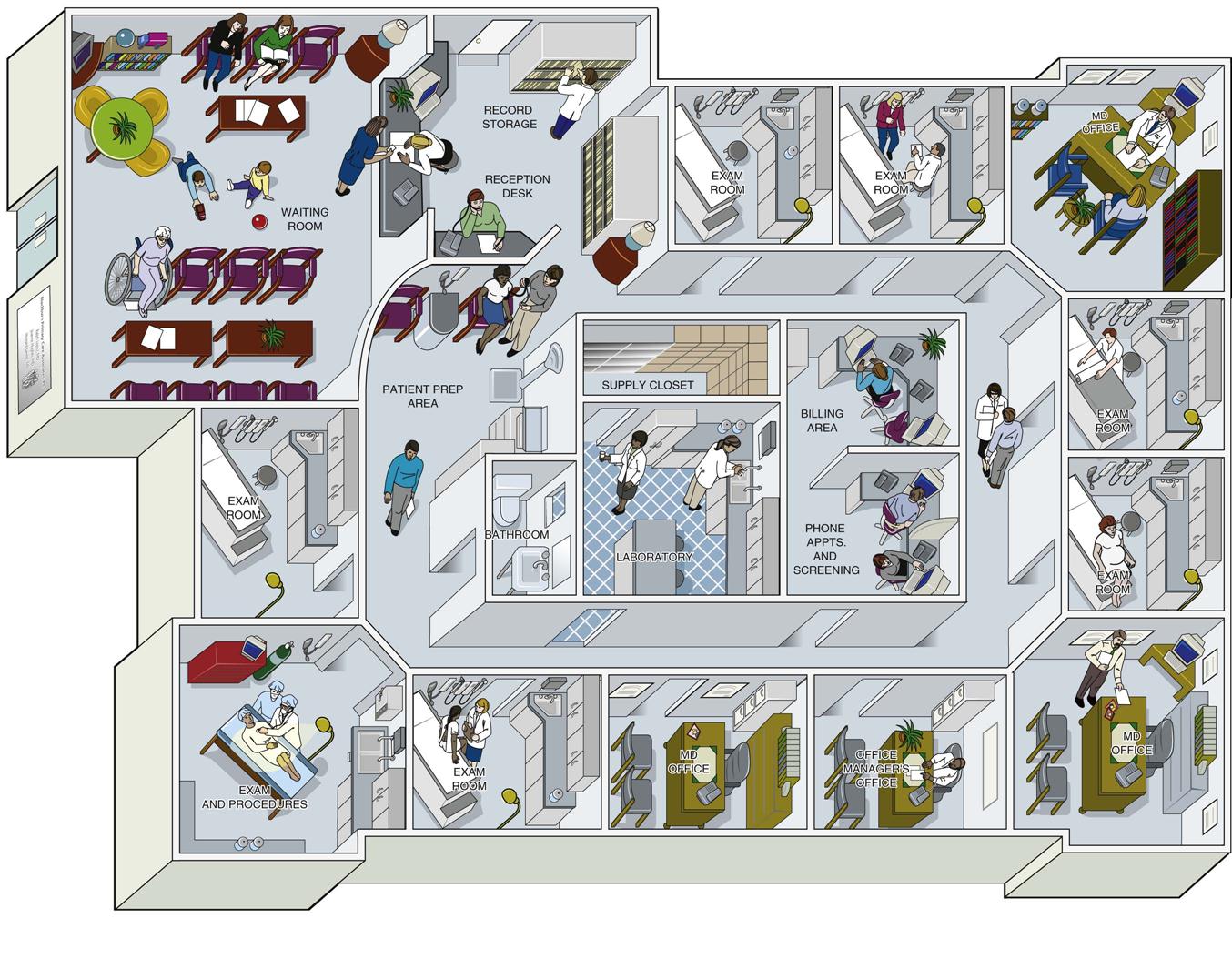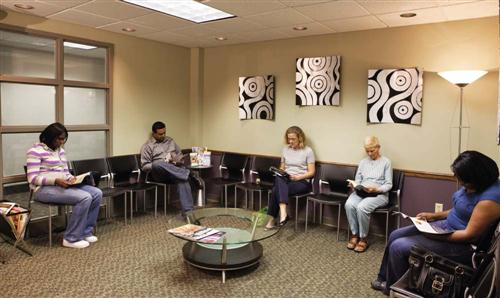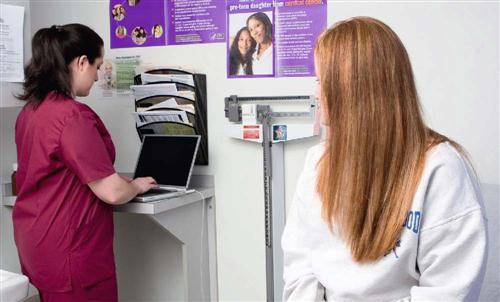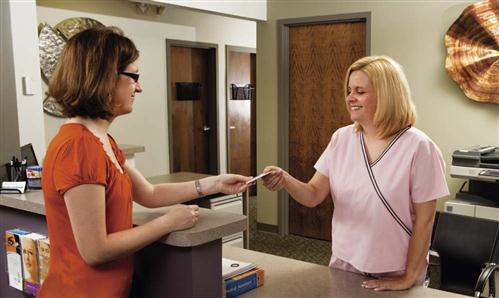1. Define, spell, and pronounce the terms listed in the vocabulary. 2. Explain the purpose of the office mission statement. 3. List several patient amenities and why these are important additions to the medical office. 4. Describe how to prepare for patient arrivals. 5. Explain why using the patient’s name as often as possible is important. 6. Discuss how the medical assistant can help the patient prepare for an examination. 7. Discuss ways to make the patient feel at ease and comfortable in the medical office. 8. Explain how to place the medical record to prevent breach of confidentiality. 9. Discuss how the medical assistant might deal with talkative patients. amenity (uh-me′-nuh-te) Something conducive to comfort, convenience, or enjoyment. demographic (de-muh-gra′-fik) The statistical characteristics of human populations (as in age or income) used especially to identify markets. fervent Exhibiting or marked by great intensity of feeling. harmonious Marked by accord in sentiment or action; having the parts agreeably related. incidental disclosure A secondary use or disclosure that cannot reasonably be prevented, is limited in nature, and occurs as a result of another use or disclosure that is permitted. intercom A two-way communication system with a microphone and loudspeaker at each station for localized use. perception A quick, acute, and intuitive cognition; a capacity for comprehension. phonetic (fuh-ne′-tik) Constituting an alteration of ordinary spelling that better represents the spoken language, that uses only characters of the regular alphabet, and that is used in a context of conventional spelling. progress notes Notes used in the medical record to track the patient’s progress and condition. sequentially (si-kwen′-shuh-le) Of, relating to, or arranged in a sequence. Most people enter the healthcare field for very specific reasons. Georgina Robertson recalls being in a serious car accident when she was 6 years old. As a result, her vision was temporarily impaired. She remembers seeing a woman in a white uniform who offered words of comfort. The woman seemed to have a haze around her; combined with the hospital lights, it made her look as if she had wings. That vision of an “angel” never left Georgina, and it led to her decision to enter the medical field. Today, Georgina works for Dr. Stuart Wade, a cardiologist in a large metropolitan area. Georgina is an experienced medical assistant, and she enjoys getting to know her patients. She makes notes on the medical record that remind her of special events in the lives of the patients who visit Dr. Wade’s office. The patients feel that she truly cares about them, aside from her duties at the clinic. Although she is efficient and time conscious, she always has a moment to share a warm smile or hear about a new grandchild. Georgina is a valued member of the medical team in her office. She currently is attending a state college in the evening hours, gaining credits toward her bachelor’s degree. She plans to continue her education and apply to medical school in the future. While studying this chapter, think about the following questions: • What are some ways to develop good rapport with patients? • Why is the sign-in register a potential breach of patient confidentiality? • What is the value of knowing some information about patients’ personal lives? The patient reception area should be an inviting place where patients feel comfortable. Visits to the physician can be times of great stress, and the office staff must do everything possible to make the experience pleasant for patients. A patient usually has a choice of healthcare providers and should be given excellent customer service. Good patient relations result in referrals to the physician, and this helps the practice grow. When patients have a good experience with a physician, they are likely to tell others. When the office staff is committed to making the patient feel welcome and the focus is on care of the patient, success of the practice is inevitable. Healthcare providers often have a fervent reason for entering the medical field. For example, a physician remembers the heritage of her immigrant grandfather. She has fond memories of her grandfather’s pride and is thankful for the opportunities he found in America after coming to the United States with nothing but the clothes on his back. The grandfather’s dream was to see his granddaughter become a physician. On the most trying days, she can step into her office and look at a picture of her grandfather. Her memories help her find the strength and determination to care for her patients. This is the source of that physician’s mission statement. A mission statement defines the predominant goals of the organization in a succinct declaration consisting of a few sentences. The statement reflects the reasons that the practice exists. The physician develops the mission statement alone or may consult the office staff for input. Many offices display the mission statement prominently in the reception area and on printed material, such as patient information booklets. Whatever the contents, each employee of the facility should be familiar with the statement and have a personal commitment to promoting the physician’s philosophy in everyday practice. A first impression is lasting. Nowhere is this more important than in the healthcare facility, where the environment must appear orderly and faultlessly clean. The facility may be a physician’s office, a hospital, a health maintenance organization, an insurance company, or one of the many other healthcare establishments. No matter the type of facility, the appearance of the reception room and the front desk, as well as a cordial greeting from the medical assistant, influence patients’ perception of the entire facility and of the care they will receive. The reception room is just that—a place to receive patients and visitors. The area should be planned for patients’ comfort; it should be as attractive and cheerful as possible and kept clean and uncluttered. Some medical assistants have the opportunity to assist in the design and decoration of this very important area. Consider the traffic flow (the movement of patients from place to place in the reception room) and the flow of traffic through the rest of the office, so that it is unhindered and logical (Figure 11-1). Fresh, harmonious colors and cleanliness are the foundation of an attractive room (Figure 11-2). Select comfortable furniture that can accommodate the peak load of patients seen each day and arrange it in conversational groups. Individual seating usually is the best choice for the physician’s office. Provide good lighting, ventilation, and a regulated temperature. Reduce room clutter by providing a place to hang coats, rainwear, and umbrellas. Most physicians’ offices are well supplied with recent magazines, and some have various books. Publications with short items of popular interest are favorites, such as Reader’s Digest. Any reading material placed in the reception room should be of interest to the general public; Good Housekeeping, U.S. News and World Report, Real Simple, Oprah, and People are examples of interesting magazines that most people enjoy reading. Some patients may donate magazines to the office; if there is a name in the subscription area, be sure to mark through it so that the patient’s name cannot be read. The reception room, incidentally, is not the place for the physician’s professional journals. A writing desk with writing paper in the reception area for the convenience of patients is a nice touch, as is restful music from a concealed speaker. A lighted aquarium or an educational display of some sort enhances the attractiveness and individuality of the reception area in the professional practice. Patients often are interested in health-related brochures. The physician also may have a DVD or healthcare book library that allows patients to check out items of interest to them. A telephone in the reception area is an asset and can be programmed by the phone company not to allow long distance calls. A television or DVD player can help the time pass much faster, especially in pediatric offices. Children enjoy Disney movies and cartoon programs, and these hold their interest until it is time to see the physician. A children’s corner equipped with small-scale furniture and some playthings works well. Youngsters who might otherwise get into mischief are kept pleasantly occupied. Toys should be easily cleanable; plastic washable items are especially good. Take extra care to ensure that no toy has sharp corners that could cause injury or small parts that could be swallowed. When selecting toys, make sure they will not stimulate the child toward noisy activity. Never place any type of ball in the reception area, because small children tend to throw them, and the balls can injure a patient or visitor. Many modern offices offer a computer for patients to use while waiting to see the physician. This is a great amenity, because patients can make good use of their time in the reception area. Some patients may bring their personal laptop computers and use their wait time to complete projects. Providing Internet access for patients also is helpful; an amazing amount of work can be done just by checking office e-mail. If patients are allowed to connect to the office network, the wise course is to provide one specific log-on name and password just for them so as to maintain control over access to private health information. Periodically, take an objective look around the reception room. Could it use a little brightening or freshening up? Try to look at the room as if seeing it for the first time. The medical assistant is responsible for the appearance of the area by making sure the room remains neat and orderly throughout the day. Check the temperature and lighting for comfort. Scan the room at intervals during the day to ensure that it is in good order. If the medical assistant’s desk is in the reception area or in open view of patients, it should be free of clutter. In particular, patients’ medical and financial records should not be in sight. Keep computer monitors out of view to protect patient confidentiality. Some offices use privacy screens that allow only the user to see the monitor, or they use a screen saver that activates after being idle for a few minutes. Medical assistants should not keep personal items on their desks. Advance preparation helps make the day go smoothly and contributes to a more relaxed atmosphere for all. Some offices prepare for the next day on the evening before, whereas others prepare each morning. The office should be consistent, and the same routine should always be performed so that important preparations are not left undone. Review a list of patients who will visit the physician during the next appointment period. If an electronic medical record system is used, this task could be as simple as pulling up and printing a report. If a paper-based system is used, pull the medical records for the day (or the next day if this is done in the evenings) and check off the patient’s name on a copy of the appointment schedule; this helps ensure that all the records have been located and are ready (Figure 11-3). Occasionally two or more patients may have the same or a similar name. Check the patient’s Social Security number, date of birth, or other pertinent information to make sure the right medical record has been pulled. Review each record to verify that any recently received information (e.g., laboratory reports, radiograph readings) has been entered correctly and permanently attached to the record (Procedure 11-1); if a document is missing, attempt to obtain it prior to the patient’s arrival using a fax or other electronic means. Arrange the medical records sequentially in the order in which the patients are scheduled to be seen. The medical assistant may be expected to place the records of all the patients to be seen that day on the physician’s desk, but the physician is more likely to prefer reviewing each record just before entering the examination room. Make sure enough space is available on the progress notes for the physician to write in the record. If not, place additional progress notes pages in the record. Every patient has the right to expect courteous treatment in a physician’s office. Regardless of the patient’s economic or social status, each person who enters the reception room should receive a cordial, friendly greeting (Figure 11-4). A personal touch, such as greeting the patient by name, is an easy way to develop patient rapport. Use the patient’s last name and title unless the patient insists on the use of his or her first name or prefers a nickname. For example, the medical assistant may say: If the office has a policy of obtaining a copy of all patients’ photo identification cards, such as the driver’s license, these can be used to identify patients and greet them by name, even if they do not visit the office often. This practice also ensures that the person receiving benefits is actually the person covered by the insurance policy. The reception desk should be in clear view of all visitors who come into the office. If only one medical assistant is present, welcoming each new visitor personally sometimes is impossible. Develop an announcement system that alerts the staff when people enter the office. Patients who enter an empty reception room do not know whether to sit down, knock on the glass partition, or try to announce themselves in some other way. Glass partitions are used to maintain some privacy; however, some physicians have eliminated them because they are so impersonal and they send the signal that the physician and staff are off limits to patients. If the partition is used, the office policy and procedure manual should dictate when the glass should remain open and when it should be closed. A sign placed in the reception room that reads, “Please sign in and sit comfortably. We will be with you shortly,” assures patients that their presence will be acknowledged. However, the best solution is to keep a staff member at the front desk at all times to greet patients and answer questions. Make sure no patient medical records are lying on the reception desk in view of patients signing in or approaching the desk when they arrive at the office. This prevents violation of the regulations established by the Health Insurance Portability and Accountability Act (HIPAA). The medical assistant should check the reception room each time he or she has been away from the desk to see whether more patients have arrived. Greet these patients by name; if you do not know the person who has entered the reception area, ask the individual’s name. Use a sign-in register that promotes patients’ privacy. Although patients can read the names of others who are in the office to visit the physician, this is not considered a violation of HIPAA policy as long as the information disclosed is appropriately limited. This is one type of incidental disclosure, as described in Chapter 17. The sign-in sheet should have only the information needed to sign in, such as the patient’s name, the provider’s name, the arrival and appointment times, and a place to note that patients are new to the practice or that their address, insurance coverage, or other demographic information has changed (Figure 11-5). The best registers allow the staff to remove the patient’s name and information after the person signs the document. Pressure-sensitive labels printed with lines for the patient’s name, the appointment time, and a “yes” or “no” question about changes in insurance coverage are a practical, inexpensive solution for confidential patient registers. The signed label then can be placed in a separate log book or even inside the patient’s medical record. The office can order custom registers that work like a pegboard, making the identifying information invisible to subsequent patients. Patients should not be expected to provide details of the reason for their visit in a public area.
Patient Reception and Processing
Learning Objectives
Vocabulary
Scenario
The Office Mission Statement
The Reception Area
Preparing for Patient Arrival
Preparing Medical Records
Greeting the Patient
Patient Check-In
Nurse Key
Fastest Nurse Insight Engine
Get Clinical Tree app for offline access










